Abstract
Intramucosal 5-aminosalicylic acid (5-ASA) and acetylated 5-ASA (Ac-5-ASA) concentrations were determined in ileocolonic biopsy specimens from 61 patients with irritable bowel syndrome treated for one week with near equimolar doses of different slow release preparations of 5-ASA (Claversal, Asacol, or Pentasa) or azo-bound drugs (Salazopyrin, Dipentum). The transit time in these patients was accelerated by a laxative, metoclopramide, and colonic lavage. The presence of 5-ASA in the mucosa was confirmed by autofluorescence. The highest concentrations of 5-ASA were obtained after Asacol (mean (SEM), 298.5 (37.3) ng/mg wet wt), followed by Claversal 500 mg (108.8 (11.7) ng/mg wet wt) and Pentasa (25.7 (2.2) ng/mg wet wt). Very low concentrations only were observed after Claversal 250 mg (0.3 (0.03) ng/mg wet wt), Salazopyrine (1.2 (0.1) ng/mg wet wt), and Dipentum (11.0 (3.2) ng/mg wet wt). The results for Ac-5-ASA were similar but the concentrations were generally lower. Serum concentration-time curves over eight hours were obtained from 34 healthy volunteers after a single oral dose of 400 to 500 mg of the different drugs. For the slow release forms, an apparently inverse relationship was found between the area under the curve of the serum concentrations and the intramucosal concentrations, supporting the importance of the local availability of the drug. This inverse relationship was absent for the azo-bound drugs. Colonic washout induced mechanical removal of intraluminal 5-ASA with a secondary disturbance in absorption resulting in a rapid decline in the serum concentrations. However, only for Dipentum did this result in significantly lower 5-ASA mucosal concentrations. This is the first reported attempt to evaluate the mucosal availability of 5-ASA after different oral preparations. It shows that where transit time is accelerated higher mucosal concentrations occur after slow release preparations (except for Claversal 250 mg) than after azo-bound drugs. Additional studies are necessary to correlate these concentrations with clinical effects.
Full text
PDF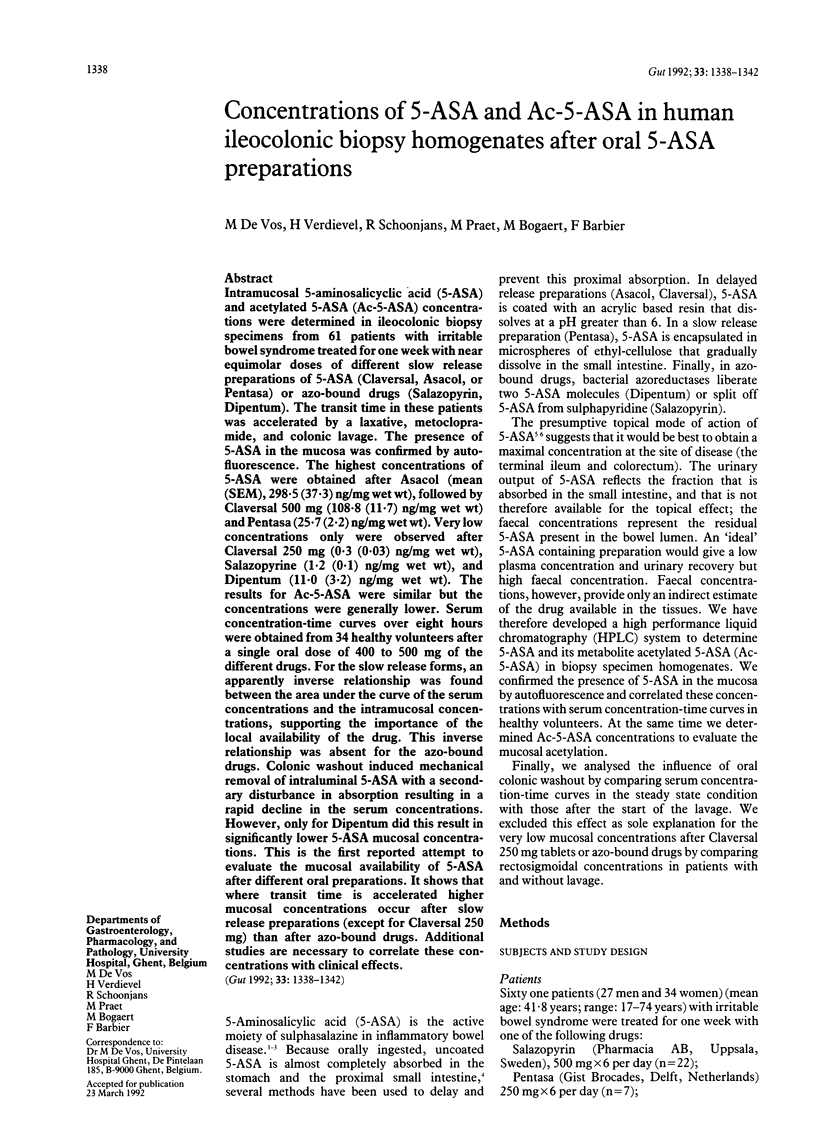
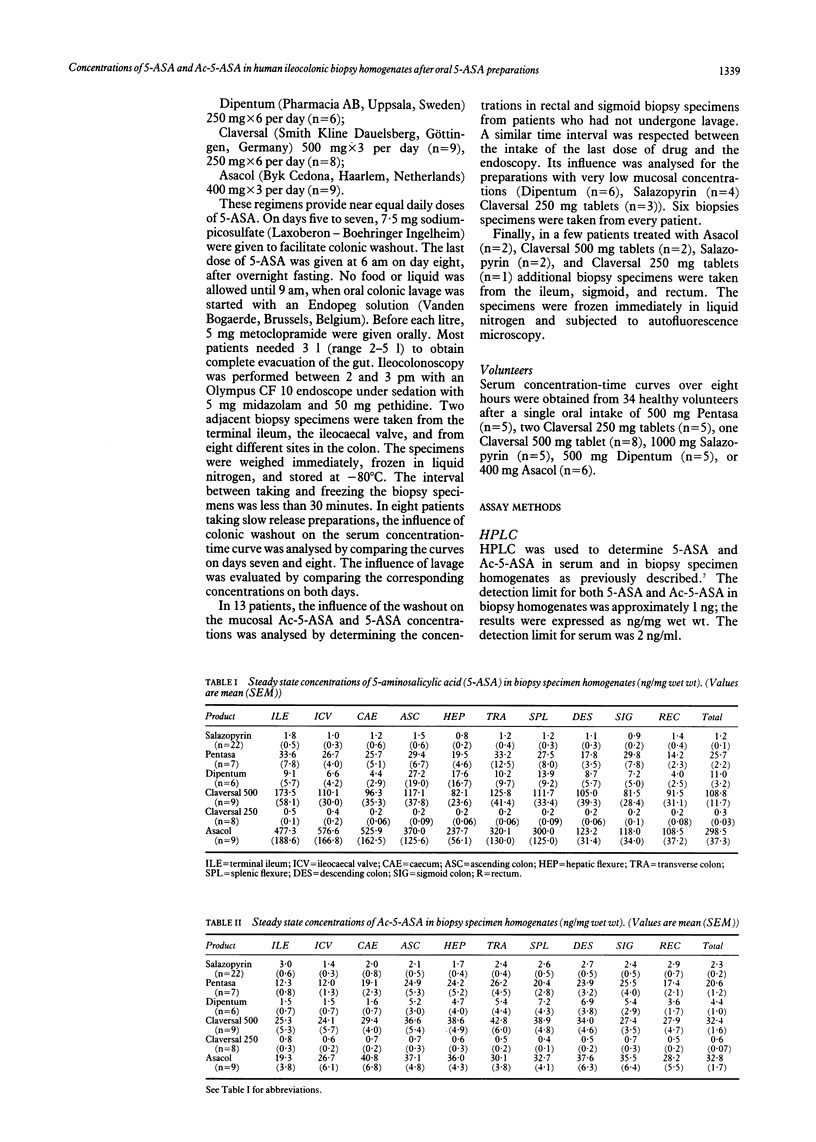
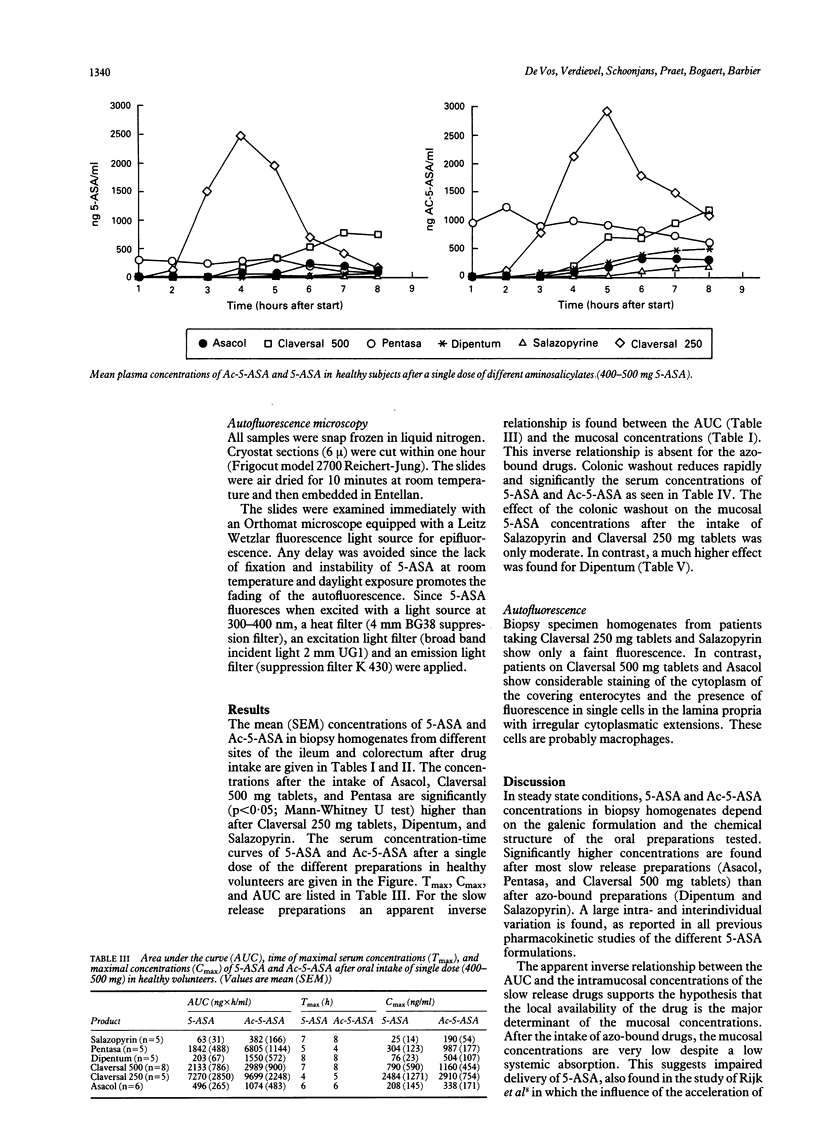
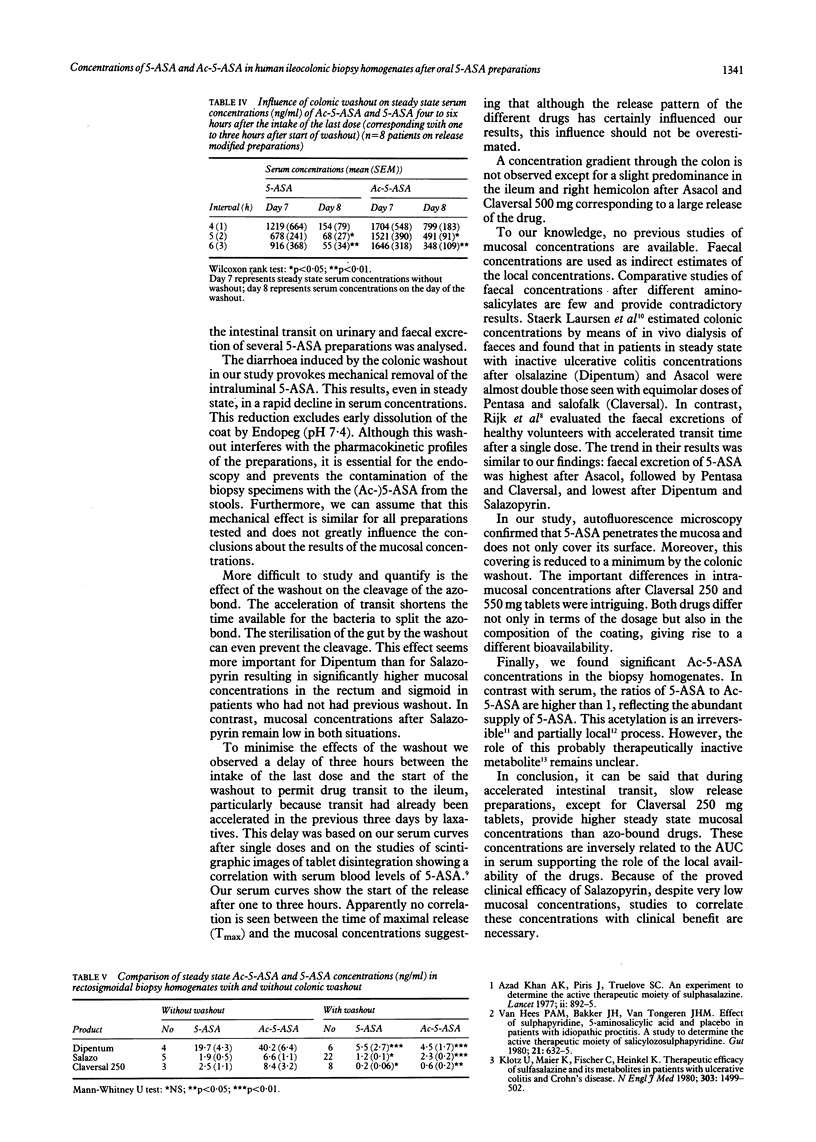
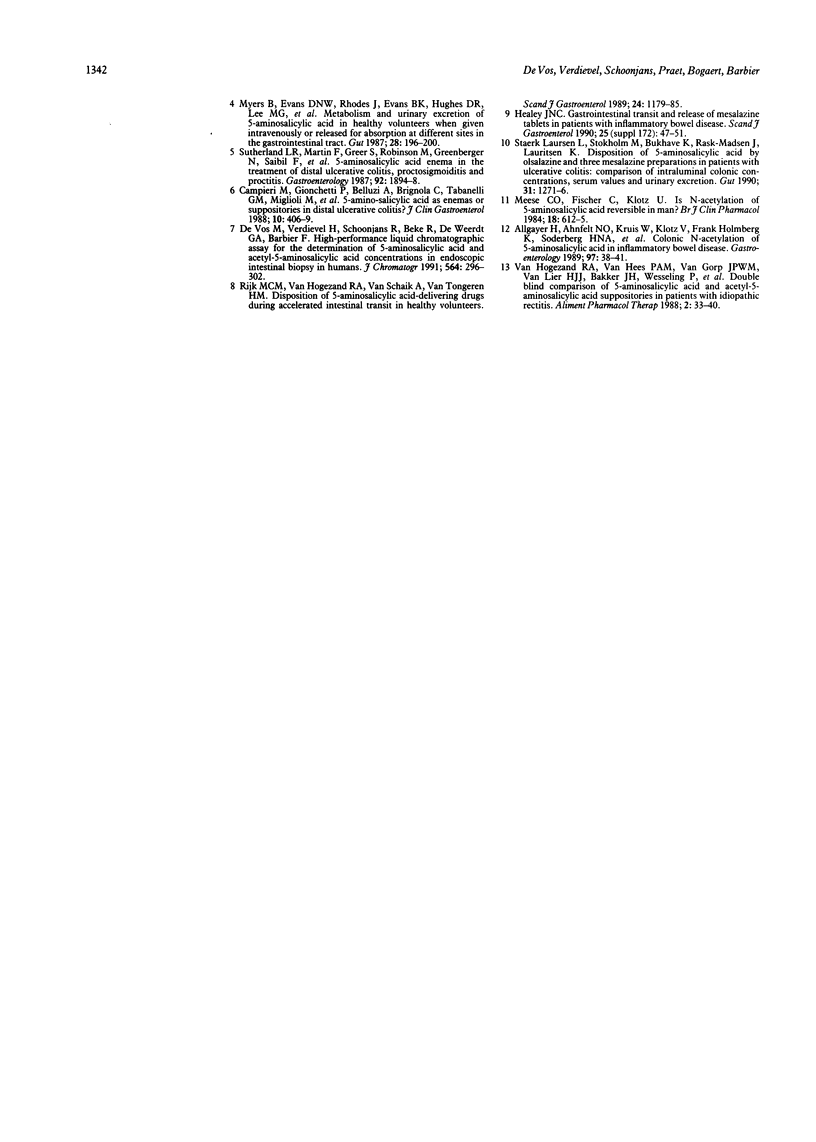
Selected References
These references are in PubMed. This may not be the complete list of references from this article.
- Allgayer H., Ahnfelt N. O., Kruis W., Klotz U., Frank-Holmberg K., Söderberg H. N., Paumgartner G. Colonic N-acetylation of 5-aminosalicylic acid in inflammatory bowel disease. Gastroenterology. 1989 Jul;97(1):38–41. doi: 10.1016/0016-5085(89)91412-1. [DOI] [PubMed] [Google Scholar]
- Azad Khan A. K., Piris J., Truelove S. C. An experiment to determine the active therapeutic moiety of sulphasalazine. Lancet. 1977 Oct 29;2(8044):892–895. doi: 10.1016/s0140-6736(77)90831-5. [DOI] [PubMed] [Google Scholar]
- Campieri M., Gionchetti P., Belluzzi A., Brignola C., Tabanelli G. M., Miglioli M., Barbara L. 5-Aminosalicylic acid as enemas or suppositories in distal ulcerative colitis? J Clin Gastroenterol. 1988 Aug;10(4):406–409. doi: 10.1097/00004836-198808000-00012. [DOI] [PubMed] [Google Scholar]
- De Vos M., Verdievel H., Schoonjans R., Beke R., De Weerdt G. A., Barbier F. High-performance liquid chromatographic assay for the determination of 5-aminosalicylic acid and acetyl-5-aminosalicylic acid concentrations in endoscopic intestinal biopsy in humans. J Chromatogr. 1991 Mar 8;564(1):296–302. doi: 10.1016/0378-4347(91)80094-s. [DOI] [PubMed] [Google Scholar]
- Healey J. N. Gastrointestinal transit and release of mesalazine tablets in patients with inflammatory bowel disease. Scand J Gastroenterol Suppl. 1990;172:47–51. doi: 10.3109/00365529009091910. [DOI] [PubMed] [Google Scholar]
- Klotz U., Maier K., Fischer C., Heinkel K. Therapeutic efficacy of sulfasalazine and its metabolites in patients with ulcerative colitis and Crohn's disease. N Engl J Med. 1980 Dec 25;303(26):1499–1502. doi: 10.1056/NEJM198012253032602. [DOI] [PubMed] [Google Scholar]
- Meese C. O., Fischer C., Klotz U. Is N-acetylation of 5-aminosalicylic acid reversible in man? Br J Clin Pharmacol. 1984 Oct;18(4):612–615. doi: 10.1111/j.1365-2125.1984.tb02513.x. [DOI] [PMC free article] [PubMed] [Google Scholar]
- Myers B., Evans D. N., Rhodes J., Evans B. K., Hughes B. R., Lee M. G., Richens A., Richards D. Metabolism and urinary excretion of 5-amino salicylic acid in healthy volunteers when given intravenously or released for absorption at different sites in the gastrointestinal tract. Gut. 1987 Feb;28(2):196–200. doi: 10.1136/gut.28.2.196. [DOI] [PMC free article] [PubMed] [Google Scholar]
- Rijk M. C., van Hogezand R. A., van Schaik A., van Tongeren J. H. Disposition of 5-aminosalicylic acid from 5-aminosalicylic acid-delivering drugs during accelerated intestinal transit in healthy volunteers. Scand J Gastroenterol. 1989 Dec;24(10):1179–1185. doi: 10.3109/00365528909090784. [DOI] [PubMed] [Google Scholar]
- Staerk Laursen L., Stokholm M., Bukhave K., Rask-Madsen J., Lauritsen K. Disposition of 5-aminosalicylic acid by olsalazine and three mesalazine preparations in patients with ulcerative colitis: comparison of intraluminal colonic concentrations, serum values, and urinary excretion. Gut. 1990 Nov;31(11):1271–1276. doi: 10.1136/gut.31.11.1271. [DOI] [PMC free article] [PubMed] [Google Scholar]
- Sutherland L. R., Martin F., Greer S., Robinson M., Greenberger N., Saibil F., Martin T., Sparr J., Prokipchuk E., Borgen L. 5-Aminosalicylic acid enema in the treatment of distal ulcerative colitis, proctosigmoiditis, and proctitis. Gastroenterology. 1987 Jun;92(6):1894–1898. doi: 10.1016/0016-5085(87)90621-4. [DOI] [PubMed] [Google Scholar]
- van Hees P. A., Bakker J. H., van Tongeren J. H. Effect of sulphapyridine, 5-aminosalicylic acid, and placebo in patients with idiopathic proctitis: a study to determine the active therapeutic moiety of sulphasalazine. Gut. 1980 Jul;21(7):632–635. doi: 10.1136/gut.21.7.632. [DOI] [PMC free article] [PubMed] [Google Scholar]
- van Hogezand R. A., van Hees P. A., van Gorp J. P., van Lier H. J., Bakker J. H., Wesseling P., van Haelst U. J., van Tongeren J. H. Double-blind comparison of 5-aminosalicylic acid and acetyl-5-aminosalicylic acid suppositories in patients with idiopathic proctitis. Aliment Pharmacol Ther. 1988 Feb;2(1):33–40. doi: 10.1111/j.1365-2036.1988.tb00668.x. [DOI] [PubMed] [Google Scholar]


